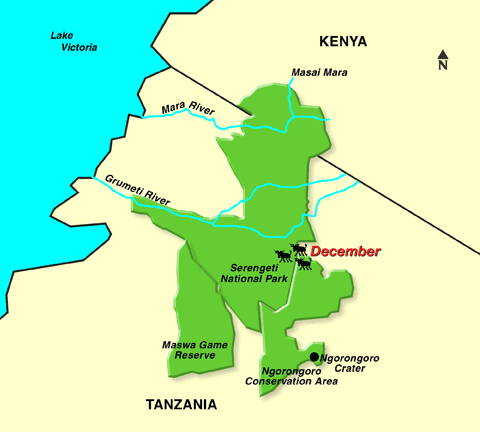The Great Migration
Each year, nearly 2 million animals move through Tanzania and Kenya driven by seasonal rain and drought in what is known as the Great Migration. One million wildebeest and 200,000 zebras make up the largest populations of the migrating herds, followed by gazelles. Though the timing of the annual migration varies from year to year and cannot be predicted with any certainty, we've outlined the general locations and movement patterns of the animals throughout the year below.

Important Note: This is a general description of the migration pattern. The exact timing of the Great Migration cannot be predicted, as it depends on each year's rainy season and other variable factors. Vacations To Go cannot be held responsible for seasonal changes that cause the migration to vary from this description.
December to April: These months find wildebeest and zebra herds scattered across the plains of the southern Serengeti and the northern Ngorongoro Conservation Area in Tanzania. Calving season generally lasts from late January through mid-March, with the largest number of calves born within a two- to three-week span in February. Hundreds of thousands of wildebeest calves are born during this time. Predators in the area take advantage of the abundance of slower calves, and sightings of species such as lions, cheetahs and hyenas are plentiful at this time of year. For a list of safaris that visit the Serengeti and Ngorongoro Conservation Area between December 2021 and April 2022, click here. For a list of safaris that visit the Serengeti and Ngorongoro Conservation Area between December 2022 and April 2023, click here.
May to July: As the plains dry up in May at the end of the long rainy season, the herds begin to move westward and then northward in search of greener pastures. The scattered herds eventually gather to form columns up to 25 miles long as they begin their trek from the south to the western and northern Serengeti. Predators, which are territorial rather than migratory, hunt as the massive herds pass through their terrain. Mating season for wildebeests also occurs during this time, between late May and early June. As the herds of zebra and wildebeest make their way northward, they must cross the Grumeti River, where hungry crocodiles wait for those that stumble. The best time to see this migration in action in the western and northern Serengeti is in June and July. For a list of safaris that visit the Serengeti in June and July of 2021, click here. For a list of safaris that visit the Serengeti in June and July of 2022, click here.
July to November: As the plains of the western Serengeti dry out and the grasses are depleted, the migration must continue. Between July and mid-August, the wildebeest, zebras and gazelles leave the Serengeti and Tanzania, cross the Mara River with its own population of crocodiles, and head into Kenya's Masai Mara, where lush green pastures await. A visit to the Masai Mara National Reserve when the migration arrives in August or September can make for an unforgettable experience due to the variety of species and the sheer number of animals. The herds scatter around the abundant grasslands of the Masai Mara until October or November, when the start of the short rainy season prompts them to begin their journey south, back to their breeding grounds in the Serengeti and Ngorongoro Conservation Area. For a list of safaris that visit the Masai Mara National Reserve in August and September of 2021, click here. For a list of safaris that visit the Masai Mara National Reserve in August and September of 2022, click here.
